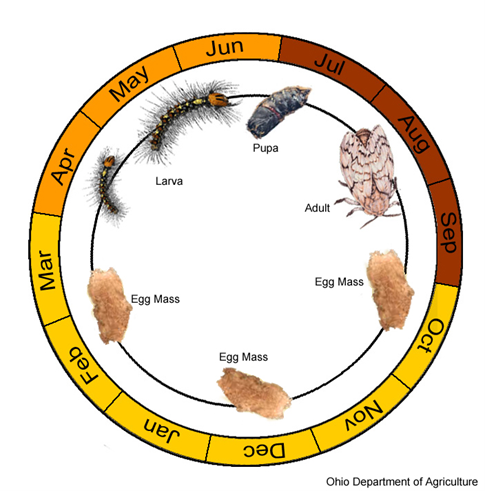Spongy moth basics
Spongy moth infestations are in the future – know the basics of spongy moth and be prepared.

Spongy moth (formerly known as gypsy moth) or Lymantria dispar is an invasive insect that can defoliate trees, and the resulting stress can kill the tree. Caterpillars in large numbers and their waste, or frass, are a nuisance in residential property and parks. New York State Integrated Pest Management offers a helpful online resource that may help answer the question, “Why do I have spongy moth?”
It’s important to note that there are a few spongy moth look-alikes. The University of Wisconsin Division of Extension provides another helpful online resource to help tell the difference between spongy moth caterpillars and other large hairy caterpillars.
Spongy moths complete one generation each year. Eggs hatch in spring, typically between early and mid-May in much of lower Michigan, and in late May or mid-June further north, as shared by Michigan State University Extension in the “Spongy Moth Life Cycle” resource by Deborah McCullough. The resource also provides more information on the spongy moth life cycle and how to access the MSU Enviroweather spongy moth egg hatch prediction model.

Spongy moths spread by many different methods. Young caterpillars hang from silk strands and are carried by the wind. Humans also move egg masses or pupa cases on travel trailers, firewood, and cars. Make sure you do not give the spongy moth a ride!
Spongy moth cannot be eradicated, but they can be suppressed to tolerable levels. To learn more about suppression methods for homeowners, the University of Wisconsin Division of Extension’s “Management guide for homeowners” is a great place to start. Larger scale infestations can warrant spraying with an insecticide called Btk, as shared by MSU Extension.
Spongy moth outbreaks typically last two to four years, then collapse, usually because the caterpillars die from viral and fungal diseases. Parasitoids, predators, starvation and unfavorable weather may also help reduce spongy moth numbers. Once an outbreak collapses, the population will remain low for some time, often several years. However, spongy moth is now part of Michigan’s ecosystem and resurgence is inevitable, so be vigilant! If you find spongy moth be sure to notify your local municipality or MSU Extension office.



 Print
Print Email
Email



